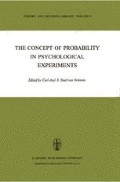Abstract
This paper explores a heuristic — representativeness — according to which the subjective probability of an event, or a sample, is determined by the degree to which it: (i) is similar in essential characteristics to its parent population; and (ii) reflects the salient features of the process by which it is generated. This heuristic is explicated in a series of empirical examples demonstrating predictable and systematic errors in the evaluation of uncertain events. In particular, since sample size does not represent any property of the population, it is expected to have little or no effect on judgment of likelihood. This prediction is confirmed in studies showing that subjective sampling distributions and posterior probability judgments are determined by the most salient characteristic of the sample (e.g., proportion, mean) without regard to the size of the sample. The present heuristic approach is contrasted with the normative (Bayesian) approach to the analysis of the judgment of uncertainty.
This study was supported by a grant from the Research and Development Authority of the Hebrew University, by NSF Grant GM 6782 to the second author, and by the U.S. Public Health Service through Grant MH-04439 to Oregon Research Institute. We thank Maya Bar-Hillel for her contributions in all phases of the project, and Ruth Beyth for her help in the collection and analysis of data. We also thank Robert P. Abelson, Ward Edwards, David H. Krantz, William Kruskal, Sarah Lichtenstein, and Paul Slovic for their many helpful comments on an earlier draft of the paper.
A more detailed version of this paper appeared in Cognitive Psychology 3 (1972). 430–454.
Access this chapter
Tax calculation will be finalised at checkout
Purchases are for personal use only
Preview
Unable to display preview. Download preview PDF.
Bibliography
Alberoni, F., ‘Contribution to the Study of Subjective Probability’, Part I. Journal of General Psychology, 66 (1962) 241–264.
Beach, L.R., Wise, J.A., and Barclay, S., ‘Sample Proportion and Subjective Probability Revisions’. Organizational Behavior and Human Performance 5 (1970), 183–190.
Cohen, J.,‘The Statistical Power of Abnormal-Social Psychological Research’, Journal of Abnormal and Sockal Psychology 65 (1962), 145–153.
Cohen, J., and Hansel, C.E.M., Risk and Gambling, Philosophical Library, New York. 1956.
Edwards, W., ‘Conservatism in Human Information Processing’, in B. Kleinmuntz (ed.). Formal Representation of Human Judgment, Wiley, New York, 1968, pp 17–52.
Extes, W.K., ‘Probability Learning’, in A W Melton (ed.), Categories of Human Learning, Academic Press, New York, 1964, pp. 89–128.
Feller, W., An Introduction to Probability Theory and Its Applications ( 3rd ed. ). Vol. I, Wiley, New York. 1968.
Garner, W.R., ‘Good Patterns Have Few Alternatives’, American Scientist 58 (1970), 34–43.
Glanzer, M., and Clark, W.H., ‘Accuracy of Perceptual Recall: An Analysis of Orgarnization’. Journal of Verbal Learning and Verbal Behavior 1 (1963), 289–299.
Goodfellow, L.D., ‘A Psychological Interpretation of the Results of the Zenith Radio Experiments in Telepathy’. Journal of Experimental Psychology 23 (1938). 601–632.
Johnson-Laird, P.N., and Wason, P.C., ‘A Theoretical Analysts of Insight Intoa Reasoning Task’, Cognitive Psychology, 1 (1970), 134–148
Jones, M.R., ‘From Probability Learning to Sequential Processing: A Critical Review’. Psychological Bulletin 76 (1971), 153–185.
Peterson, C.R., and Beach, L.R., ‘Man as an Intuitive Statistician’. Psychological Bulletin 68 (1967), 29–46.
Peterson, C.R., Schneider, R.J., and Miller, A J., ‘Sample Size and the Revision of Subjective Probabilities’. Journal of Experimental Psychology 69 (1965), 522–527.
Pitz, G F., ‘Sample Size, Likelihood, and Confidence in a Decision’, Psychcmomic Science 8 (1967), 257–258.
Pitz, G. F., Downing, L., and Remhold, H,‘Sequential Effects in the Revision of Subjective Probabilities’, Canadian Journal of Psychology 21 (1967), 381–393.
Rapoport, A., and Wallsten, T.S., ‘Individual Decision Behavior’. (Vol. 23) in Annual Review of Psychology, Annual Reviews, Palo Alto, 1972, pp. 131–176.
Shanteau, J.C., ‘An Additive Model for Decision-Making’, Journal of Experimental Psychology 85 (1970), 181–191.
Slovic, P, and Lichtenstein, S., ‘Comparison of Bayesian and Regression Approaches to the Study of Information in Judgment’, Organizational Behavior and Human Performance 6 (1971). 648–744.
Tune, G.S., ‘Response Preferences: A Review of Some Relevant Literature’. Psychological Bulletin 61 (1964), 280–302.
Tversky, A., and Kahneman, D., ‘Belief in the Law of Small Numbers’. Psychological Bulletin 76 (1971), 105–110.
Tversky, A. and Kahneman, D., ‘Availability: A Heunvtic for Judging Frequency and Probability’, Cognitive Psychology 5 (1973). 207–232.
Vitz, P.C., and Todd, T.C., ‘A Coded Element Model of the Perceptual Processing of Sequential Stimuli’. Psychological Review, 76 (1969), 433–449.
Vlek, C., ‘The Use of Probabilistic Information in Decision-Making’, Psychological Institute Report No. 009-65, University of Leiden, The Netherlands, 1965.
Wagenaar, W.A., ‘Subjective Randomnew and the Capacity to Generate Information’, in A.F. Sanders (Ed.), Attention and Performance III, Acta Ptychologica, 33 (1970), 233–242.
Author information
Authors and Affiliations
Editor information
Editors and Affiliations
Rights and permissions
Copyright information
© 1972 Academic Press
About this chapter
Cite this chapter
Kahneman, D., Tversky, A. (1972). Subjective Probability: A Judgment of Representativeness. In: Staël Von Holstein, CA.S. (eds) The Concept of Probability in Psychological Experiments. Theory and Decision Library, vol 8. Springer, Dordrecht. https://doi.org/10.1007/978-94-010-2288-0_3
Download citation
DOI: https://doi.org/10.1007/978-94-010-2288-0_3
Publisher Name: Springer, Dordrecht
Print ISBN: 978-94-010-2290-3
Online ISBN: 978-94-010-2288-0
eBook Packages: Springer Book Archive

